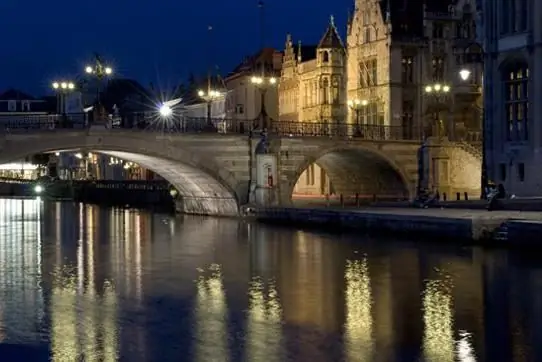- Author Harold Hamphrey [email protected].
- Public 2023-12-17 10:06.
- Last modified 2025-01-24 11:10.
Everyone is talking about the Leaning Tower of Pisa. But do you know what a miracle like a tilted building can be seen in almost every country? And sometimes, as, for example, in China, Italy or Russia, there are several of them. But PR is a great power. The Leaning Tower of Pisa, whose photos are replicated so that everyone, even an avid stay-at-home, has seen it, overshadows all other inclined buildings. And not only that: this masterpiece of medieval architecture with such a dangerous flaw began to be copied. People like to tickle their nerves and live in buildings that supposedly fall. That is why buildings are now being erected, in the design of which the angle of inclination is specially laid down. Such "falling" new buildings appeared in Dusseldorf, Abu Dhabi, Madrid, Montreal and Las Vegas. But in this article we will talk about old buildings. Some of them, such as the tower in the Spanish city of Zaragoza, did not survive the fight against gravity, but many are still standing and evenfirmly fixed their angle of inclination.

Why are they falling?
There can be many reasons for a building to deviate from the vertical axis. Architects, starting construction, must not only draw a design for the structure, but also explore the soil at the site of its construction. Sandy or swampy soils sag over time from the severity of the building, which can cause it to roll. This is what caused the Leaning Tower of Pisa to fall. The building itself of multi-colored marble is perfect. The building resembles a frozen stone lace. However, it began to roll even during its construction. Gradually, the angle of inclination became menacing. But now the restorers were able to solve this problem. They completely secured the soil under the base of the tower and stopped its fall. Earthquakes often destroy buildings or … tilt them. The movement of tectonic plates can also cause tall towers to roll. This process is not as fast as an earthquake, but over the years the angle of inclination becomes more and more noticeable. Now, if you look closely at London's Big Ben, you can see that it is almost half a meter shifted to the northwest. There are also such “falling” buildings that appeared not as a result of an engineering miscalculation, but, on the contrary, as a result of ingenious foresight. There are many such towers in China. The architects, taking into account the wind rose and the soil, specifically gave the buildings such an angle of inclination so that they were more stable.

The most falling tower
Where is this record holder? This is by no means the Leaning Tower of Pisa. Atof the world-famous Italian construction, the angle of inclination is only 5.2 degrees. But the Huzhu tower, which is located in the Tian Ma mountains in the Chinese province of Songjiang near Shanghai, tilted 6.63 degrees. In addition, this seven-story stone structure, nineteen meters high over Cham, is a hundred years older than its Pisan rival. It was erected under Emperor Yuanfeng, around 1079. The tower was originally conceived as an inclined one. Strong southeasterly winds often blow in this place. The tower is tilted in the opposite direction so that air currents support it. They say that if the building were made strictly vertical, it would have collapsed long ago. With the same calculation, in 1621, the Guilun Dragon Tower was erected on Jiang-sin Island in the middle of the Yujian River. Its top is deviated from the base by more than a meter.

Modest record holder
If the main criterion is not the deviation of the top from the base (measured in meters), but simply the angle of inclination from the earth's surface, calculated in degrees, then a small nameless leaning tower takes the lead. The country of China, Liaoning Province, Suizhong County - these are its coordinates. The angle of incidence - as much as twelve degrees - is two and a half times greater than that of the Leaning Tower of Pisa. However, the Chinese structure is small. It consists of three floors and has only ten meters in height (against 90 m at the Leaning Tower of Pisa). Therefore, the deviation of the top from the base is small.
The oldest leaning tower
It is also located in China. This is the Huqiu tower. Octagonala seven-story black brick building was erected under Xiande (Later Zhou Dynasty) around 959. The reason for the tilt in this case (from this most often falling towers appear) is the lack of architects. Soft soils sank over time, and now the Chinese restorers have a big problem: how to stop the fall of the ancient landmark. The situation became dangerous: the old brick began to crumble. In 1981, the degree of subsidence was stabilized. The angle of inclination was also fixed. It is 2.47 degrees. At the same time, the top is 2.32 meters away from the base.

Falling towers in Russia
In our country, you can also often find tilted (sometimes at a rather dangerous angle) buildings. The most famous is the Nevyansk Tower. It is located in the district center of the Sverdlovsk region of the same name. This is an eighteenth century monument. However, the glory of the Nevyansk tower was brought not by a noticeable angle of inclination, but by a unique auditory room. It has excellent acoustics. There, in the Urals, there is also a bell tower at the cathedral in the city of Usolye. In Kazan, in the local Kremlin, the top of the Syuyumbike tower deviated from the base by almost two meters. And, finally, in Solikamsk, at the Ex altation of the Cross Cathedral, there is also a “falling” bell tower. Interestingly, Russian folk thought never attributes the reasons for the tilt of buildings to the movement of tectonic plates, subsidence of soils or engineering miscalculations. The devils are always to blame, the death of the Kazan princess (Syuyumbike) or the nostalgia of the architect Athanasius for his native Tula (Nevyansk).

Pisa, Bologna, Venice, Rome
The famous bell tower at the Cathedral of Pisa is not the only leaning tower in Italy. And even in this city there is another sloping structure. This is the bell tower of the monastery church of St. Michael of the Order of the Barefoot. Once upon a time, medieval cities had secular tower houses where noble families lived. Two such buildings remained in Bologna - the Torre degli Asinelli (a hundred meters high) and the Torre Garisenda half as low as it. Both stand on Rizzoli Street and are the symbol of Bologna. There are also two leaning towers in Venice. The first is located on the island of Burano. This is the bell tower of the church of San Martino. The second is located in the Kastelo area. This is the bell tower of the Greek Orthodox Church of San Giorgio dei Grechi. The earthquake of 1348 turned the previously straight Militia tower (erected under Pope Innocent III) into a falling one.
Crooked Towers of Poland
Swampy terrain, strong steady winds, plus construction flaws have created falling towers in this country. True, they are modestly called "curves". The most famous of them is Kshiva Vezha in Torun. It is part of the medieval defensive structures of the city. Raised in the thirteenth century. Since then, it has deviated from the vertical by one and a half meters. Another "Kshiva Vezha" is located in the town of Zombkowice-Slańsk, which is at the church of St. Anne (1413). Due to the displacement of tectonic plates at the end of the 16th century, the tower began to roll. Now its slope is two meters. The tower houses the Frankenstein Museum. In Wroclaw, to the oldest building in the city, the Church of St. Idzi adjoins the crooked Chapterhouse Tower.

Tilted belfries and other buildings
We can only list the falling towers scattered around the world. This is the Old Church (Oude Kerk) in the Dutch town of Delft, the Church of St. Margaret in the Romanian Medias. Due to the peculiarity of the soils of such inclined buildings, at least a dime a dozen in the UK and Ireland. You can call the Greyfriars tower in King's Lynn, Bridgnorth (Shropshire), Kilmacdu in Galway (Ireland), Caerphilly Castle in Wales, Albert's clock tower in Belfast. In Germany, in Ulm, there is also a leaning tower with an inclination of 3.3°. And even in the Kyiv Lavra, the Great Bell Tower tilted 62 centimeters in the northeast direction, which is very noticeable with a building height of 96 meters.






